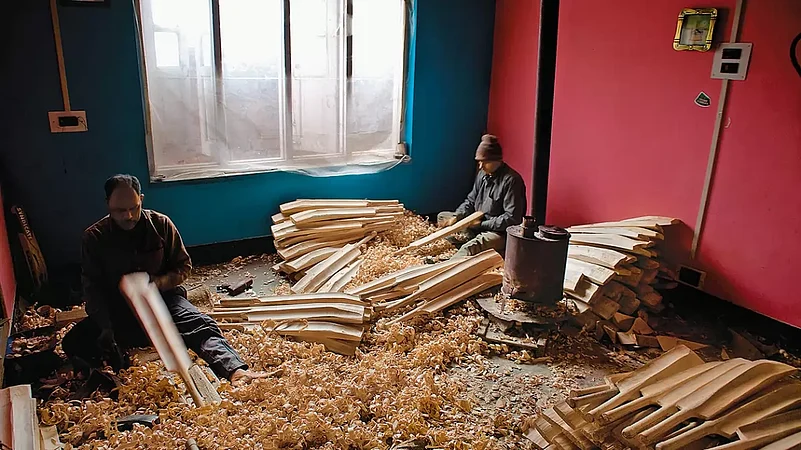In the 17th over of a T20 World Cup match between the United Arab Emirates (UAE) and Sri Lanka on October 18 at Kardinia Park in Geelong, Australia, Junaid Siddiqui of UAE hit Sri Lankan bowler Dushmantha Chameera for a six. The ball ballooned into the sky and went out of the park, travelling 109 metres.
Even though UAE lost the match to Sri Lanka, getting bowled out for 73 in 17.1 overs while chasing a target of 152, the mammoth six was a little moment of victory for a small village in Kashmir.
As Siddiqui held up his bat after hitting the six, Fawzul Kabeer, 30, jumped in joy in front of his TV set at his home in Sangam, a village 44 km south of Kashmir’s capital Srinagar. The reason for Kabeer’s joy was the bat that Siddiqui was using. It had been manufactured by his company, Gr8.
“I will remember it as the best moment for Kashmir’s willow bat industry,” Kabeer tells Outlook. Most of the UAE players are using bats made in Sangam.
The willow of the Valley
Kabeer’s father Abdul Kabeer Dar started their company in the 1970s, around the time Kashmir residents ventured into the bat-manufacturing business. Now, those driving on the Srinagar–Jammu highway that passes through Sangam are greeted with several shops displaying cricket bats made out of the famed Kashmiri willow on both sides of the road. Piles of wood clefts line the road. Many of the bats manufactured in the village travel around the world without any branding.
But the use of Kashmiri willow to make cricket bats dates back to the 19th century. Sir Walter Lawrence, who served as the first settlement commissioner of Kashmir, wrote in his well-known book, The Valley of Kashmir, published in 1895, that Kashmiri willow was used for timber and fuel and was not highly valued. “The vir, or willow, grows in every village of Kashmir where there is water or moisture, and its reproduction is very simple,” he wrote. “There is an enormous waste of withies every year, as the young wands are cut down for fodder and after being stripped of their leaves are burnt for fuel.”
He suggested that Kashmiris should be sent to England to learn the art of weaving baskets. “There is ample material in the valley to supply the whole of India with excellent baskets and chair,” he said, while suggesting that Kashmiri willow could be used for making cricket bats.
Research by the Directorate of Handicrafts and Handloom, Jammu and Kashmir, and the NIFT Srinagar shows that one Allah Baksh, an industrialist from Sialkot, now in Pakistan, set up the first units for making cricket bats in Kashmir in the late 19th century. A technical expert from England was hired to teach the locals how to convert willow logs into clefts and then into bats. British Navy officers interested in playing cricket often bought bats made in Kashmir.
After Partition in 1947, many of the manufacturers moved to Meerut in Uttar Pradesh and Jalandhar in Punjab. They continued to source raw material and even products from Kashmir. Kashmiri bats would be branded in these places and exported all over the world.
A new innings
“This did not help the Kashmiri bat industry at all,” says Kabeer. “I always wondered if we were producing the bats, why Kashmir had not produced an international brand?”
He started taking samples of his finished bats to the UEA and other cricket-playing nations. Soon, he realised Kashmiri manufacturers had no clue about how to make an international-quality bat.
“In Australia, you need a bat that suits the weather conditions of the country,” he says. “In South Asia, you have to come up with different bats. For the pitches where the ball bounces, the sweet spot of the bat should be a bit higher. For the pitches where the ball is slow and dead, the sweet spot of a bat should be at the lower end.”

“We didn’t know these technicalities,” he says, adding that because of this ignorance, his outreach did not yield any result in the international market for many years.
Officials of the International Cricket Council (ICC), the global governing body of cricket, in the UAE gave him technical advice.
“They were impressed with my efforts,” says Kabeer. “They specified their requirements. They told me what should be the size of the bat. They talked about its shape, curvature and the physics of the handle of a bat.”
On the home pitch
Back home, he started visiting Meerut and Jalandhar to meet the craftsmen who would make bats for cricketing greats such as Sachin Tendulkar from India, Brain Lara from the West Indies and Kumar Sangakkara and Arjuna Ranatunga from Sri Lanka. “Senior and retired craftsmen usually don’t share secrets of their craft but they gave some information in bits and recommended some younger craftsmen,” says Kabeer.
He recruited some of these craftsmen and started making bats of international standards. Finally, in 2018, the ICC’s cricket academy approved his bats. But this was only the beginning of a long innings.
“The Kashmiri willow is fine, but there are no buyers,” he says. “Importers in the UAE and other countries were not keen to buy our bats, either.
Turning point
Players of the Oman cricket team liked Kabeer’s bats. “During a practice session, one of the batsmen hit a six using one of my bats,” he says. “That was the turning point.”
In 2021, Oman qualified for the ICC T20 Cricket World Cup. Three players of the team—Naseem Khushi, Bilal Khan and Kaleemullah—used Kabeer’s bats in the tournament. During a match with Bangladesh on October 19, 2021, Khushi hit a six as well with one of these bats.
“Bat manufacturers watch everything,” he says. “They saw our bat and started inquiring about it. We sent samples to all cricket-playing nations through their importers. We provide the world with a Kashmir willow bat, a substitute for English willow. Our motive is that the Kashmir willow industry should grow.”
This year alone at least 12 Kashmiri bat manufacturers exported 1.5 lakh pieces to different countries without any intermediary. Kashmir has around 400 bat-making units and it produces 3.5 million bats each year.
The Kashmiri willow bat industry is now the largest of its kind in Asia. A hundred and forty-seven units now employ 20,000 people in the Valley.
Punching above its weight
In international cricket, the cost-effectiveness of the Kashmiri willow makes it popular. On average, a bat made of English willow costs over £1,200. The ones made in Kashmir can be bought for as low as £100.
But there are still many challenges. There is, for instance, a paucity of raw materials as willow is not being cultivated on a large scale. Farmers prefer poplars over willow because the former takes only three-four years to grow, while the latter takes 15 years.
“We have a large number of customers now, we are generating more than Rs 100 crore in revenue. We need to cultivate 15,000 trees annually but grow only around 1,500,” says Bat Manufacturers Association, Kashmir, president Nazir Ahmad Salroo.
There is also rampant smuggling of the wood to places like Jalandhar and Meerut, says an official of the handloom department, who did not want to be named.
The official also says that till the mid-1970s, Kashmiri willow was freely sent to other parts of the country. However, as the state government realised its value, it tried to curb the outflow of willow. Now, about 25 lakh clefts of willow are smuggled out of the state every year, he adds.
(This appeared in the print edition as "Famed & Unbeatable")
By Naseer Ganai in Anantnag
















